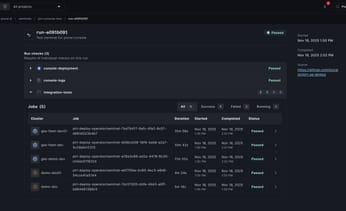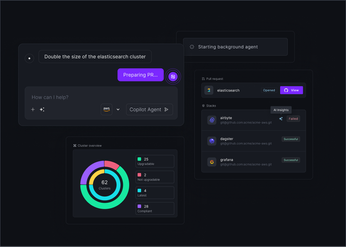
Your Guide to Linode Kubernetes Engine (LKE)
Get practical tips for deploying, managing, and scaling applications with Linode Kubernetes. Learn how to streamline operations across multiple clusters.
Adopting a GitOps workflow is key for automated and auditable deployments. While the Linode Kubernetes Engine (LKE) provides a strong foundation, it doesn't manage your application configurations or infrastructure code for you. As you scale, managing application lifecycles and securing your Linode Kubernetes environment across multiple clusters becomes a real challenge. This guide shows how to implement Plural on LKE. You'll get a single pane of glass for GitOps deployments, infrastructure automation, and centralized observability for your entire fleet, simplifying how you manage RBAC and security policies.
This guide outlines how to implement an enterprise-grade GitOps workflow on LKE using declarative configurations to manage everything from application deployments and network policies to persistent volumes. By treating your entire infrastructure as code, you can build a scalable, consistent, and low-touch platform that significantly reduces manual intervention and operational risk.
Unified Cloud Orchestration for Kubernetes
Manage Kubernetes at scale through a single, enterprise-ready platform.
Key takeaways:
- LKE provides a solid foundation for individual clusters: Linode Kubernetes Engine simplifies running containerized applications by managing the control plane, offering a cost-effective and direct way to get started with Kubernetes for single projects or teams.
- Manual management becomes unsustainable at scale: As you expand from one cluster to a fleet, relying on manual configuration leads to inconsistencies, security gaps, and operational bottlenecks. A declarative, automated approach is necessary to manage multiple environments effectively.
- A unified platform is essential for fleet management: Implement a platform like Plural to apply consistent GitOps workflows, infrastructure-as-code practices, and centralized security policies across all your LKE and multi-cloud clusters, solving the challenges that arise with scale.
What is Kubernetes and Why Use it on Linode?
Kubernetes is the industry-standard platform for orchestrating containerized applications. Managed services like the LKE simplify its adoption by abstracting away control plane complexities, enabling teams to deploy faster and focus on development rather than infrastructure. LKE offers a stable, cloud-native environment ideal for both beginners and growing teams.
As organizations scale from a single cluster to multiple environments, new challenges emerge, such as maintaining deployment consistency, enforcing security policies, and achieving unified observability. Solving these requires not just familiarity with Kubernetes, but also a robust management layer. While LKE provides the foundation, a platform like Plural equips you to manage your entire fleet with consistent GitOps workflows, automated upgrades, and centralized visibility.
What is Container Orchestration?
At its core, container orchestration automates the deployment, scaling, networking, and management of containers. As applications grow in complexity, manual oversight becomes error-prone and unsustainable. Orchestration platforms like Kubernetes provide a declarative API, powerful scheduling, service discovery, and automated rollouts, ensuring workloads are resilient and infrastructure is abstracted away from the developer experience.
Kubernetes has become the de facto orchestration standard due to its flexibility, reliability, and thriving ecosystem. It manages the full container lifecycle—scheduling, scaling, load balancing, and self-healing—allowing teams to ship features without worrying about low-level infrastructure.
Why Choose Kubernetes for Your Applications?
Running applications on Kubernetes brings significant benefits:
- Auto-scaling in response to demand spikes
- Self-healing for failed containers and nodes
- Zero-downtime deployments via rolling updates
Services like LKE make getting started simple, provisioning production-ready clusters in minutes. But while Kubernetes offers power and flexibility, it also introduces challenges around configuration complexity, resource tuning, and multi-cluster management.
That’s where tools like Plural come in. It provides a centralized platform to manage infrastructure as code, enforce policy and security best practices, and maintain full observability across your clusters—turning your LKE environments into a scalable, reliable platform that’s ready for long-term growth.
Kubernetes Adoption and Market Trends
Kubernetes has moved far beyond being a niche tool; it's now the de facto standard for container orchestration. Its growth is reflected in its nearly universal adoption, with reports showing that 96% of organizations are either using or evaluating it. This trend is driven by its powerful capabilities for automation, scaling, and resilience. However, as companies expand from a single cluster to a fleet spread across different clouds or on-premise environments, they quickly encounter the operational complexities of managing distributed systems. Manual configuration becomes unsustainable, leading to inconsistencies, security vulnerabilities, and operational bottlenecks. Successfully scaling Kubernetes requires a strategic shift toward automated, centralized management to enforce consistent policies and maintain visibility across the entire infrastructure.
What is Linode Kubernetes Engine (LKE)?
LKE is a fully managed Kubernetes service from Akamai’s Linode, designed to simplify the deployment, scaling, and management of containerized applications. Its key strengths lie in combining ease of use, reliable performance, and predictable pricing, making it a strong choice for teams new to Kubernetes as well as seasoned users seeking a cost-effective alternative to hyperscalers.
While LKE streamlines single-cluster operations, platform teams often operate across multi-cloud or hybrid environments. Managing clusters on LKE, AWS (EKS), and GCP (GKE) introduces complexity and fragmentation. This is where centralized management becomes essential. Tools like Plural offer a unified control plane for orchestrating deployments, managing infrastructure as code, and enforcing security policies consistently across all environments—allowing you to leverage LKE's affordability without sacrificing control or visibility.
Key Features of the Linode Kubernetes Engine
LKE provides all the essentials needed to run production-grade Kubernetes workloads:
- Managed control plane: Linode handles availability, patching, and version upgrades of the Kubernetes master components, abstracting away significant operational overhead.
- High availability by default: Control planes are designed for resilience, ensuring application uptime.
- Integration with Linode ecosystem: Seamlessly connect with NodeBalancers for load balancing and Block Storage for persistent volumes.
- Cluster autoscaling: Worker node pools automatically scale based on workload demand.
You can explore the full list of capabilities in the LKE documentation. These features create a solid foundation for modern app deployment—even without deep Kubernetes expertise.
CNCF-Certified Kubernetes Conformance
LKE is a CNCF-certified Kubernetes distribution, which guarantees that it adheres to community standards for API compatibility and interoperability. This certification ensures your workloads are portable and that you can avoid vendor lock-in, as your applications will behave predictably on any compliant Kubernetes platform. While conformance provides a reliable baseline for the Kubernetes control plane and worker nodes, it doesn't address the configuration drift that can occur at the application and infrastructure layers. A platform like Plural builds on this foundation by using GitOps to enforce consistency for your deployments, policies, and add-ons across your entire fleet, ensuring that every cluster—whether on LKE or another provider—is configured identically.
Support for GPU-Enabled Nodes
For workloads that demand intensive parallel processing, such as AI/ML model training or scientific computing, LKE supports the use of GPU-enabled nodes. This allows you to attach powerful graphics cards to your clusters and run specialized, high-performance applications. Managing these deployments often involves complex dependencies, including specific drivers and resource requests. With Plural, you can declaratively manage the entire stack as code. Using Plural Stacks, you can automate the provisioning of GPU instances with Terraform and then use our GitOps engine to deploy the corresponding application manifests, ensuring that even your most complex, resource-intensive workloads are deployed in a repeatable and auditable manner.
How LKE Simplifies Cluster Management
LKE’s key simplification lies in abstracting the Kubernetes control plane. You define your cluster size by selecting Linode Compute Instances as worker nodes, while Linode manages the master components behind the scenes, including upgrades and availability.
Clusters can be deployed quickly using the Linode Cloud Manager, API, or Terraform provider. This reduces administrative overhead and accelerates developer workflows.
For organizations managing multiple clusters, Plural’s GitOps-based platform extends this simplicity by enabling centralized, declarative configuration across all clusters—whether on LKE, EKS, or GKE.
LKE vs. LKE-Enterprise
Linode offers two tiers of its managed Kubernetes service to meet different operational needs. The standard Linode Kubernetes Engine (LKE) is an excellent choice for development, testing, and production applications that require a cost-effective, straightforward platform. It abstracts away control plane management, allowing teams to get started quickly. However, as applications become more business-critical and performance-sensitive, the requirements change. LKE-Enterprise is designed for these demanding workloads, offering dedicated resources and a formal service-level agreement (SLA) to guarantee reliability. Choosing between them depends on your application's performance needs, uptime requirements, and overall scale.
LKE-Enterprise for High-Performance Workloads
LKE-Enterprise is built for applications where consistent performance is non-negotiable. It provides dedicated compute resources, which means your workloads are isolated from other tenants, eliminating the "noisy neighbor" effect that can degrade performance on shared infrastructure. This is critical for latency-sensitive services, large databases, or intensive data processing jobs. Furthermore, LKE-Enterprise supports clusters with over 500 nodes, providing the scale needed for massive applications. Managing a fleet of such high-performance clusters requires robust automation. A platform like Plural provides the necessary GitOps workflows and centralized control to deploy and manage configurations consistently across these large-scale environments.
Understanding the 99.9% Uptime SLA
For business-critical applications, reliability is paramount. LKE-Enterprise includes a financially backed 99.9% uptime SLA for its worker clusters, providing a formal guarantee that your applications will remain available. This translates to less than nine hours of potential downtime per year, offering a level of assurance that standard LKE does not. While Linode guarantees the infrastructure's availability, ensuring your applications run without interruption also depends on your deployment practices. Using Plural to manage your LKE-Enterprise clusters adds another layer of reliability by automating deployments through auditable GitOps pipelines, which helps prevent configuration errors and minimizes the risk of human-induced downtime.
Why Choose LKE Over Other Solutions?
LKE stands out for its:
- Predictable pricing: Flat hourly rates for control plane usage and transparent per-node billing—unlike the often opaque pricing models of hyperscalers.
- Ease of use: A clean UI, simple provisioning, and tight integrations make it beginner-friendly.
- Cost efficiency: Ideal for startups and SMBs looking to manage Kubernetes infrastructure without overspending.
For larger enterprises, LKE supports advanced use cases when paired with tools like Plural. You can uniformly manage RBAC policies, deploy applications declaratively, and maintain consistent security and compliance standards across your entire multi-cloud Kubernetes fleet.
How to Set Up Your First LKE Cluster
Setting up a Linode Kubernetes Engine (LKE) cluster is a streamlined way to begin deploying containerized applications. LKE, part of Akamai Connected Cloud, offers a managed Kubernetes control plane that abstracts away the complexity of running master nodes—freeing you to focus on your workloads.
This guide walks you through creating your first LKE cluster using the Linode Cloud Manager and connecting to it with kubectl. While this manual process is suitable for individual clusters or development environments, we’ll also highlight how to scale operations using a platform like Plural to automate and manage Kubernetes across your fleet.
Step 1: Preparing Your Account and Prerequisites
Before provisioning an LKE cluster, you’ll need:
- A Linode account
kubectlinstalled on your local machine
Once your account is active, log in to the Linode Cloud Manager—the web UI for provisioning and managing cloud resources. kubectl is the standard CLI for interacting with Kubernetes clusters, used to deploy apps, inspect resources, and monitor health.
Step 2: Create Your LKE Cluster
To create a cluster:
- Navigate to the Kubernetes section in Cloud Manager and click Create Cluster.
- Assign a label, choose a region, and select a Kubernetes version—preferably the latest stable release.
- Define node pools, which determine the hardware resources for your worker nodes. Select a Linode plan and specify the number of nodes (start with 1–2 for testing).
Linode will provision both the control plane and worker nodes automatically. This UI-driven setup is great for learning, but in production environments, declarative tools like Terraform and platforms like Plural Stacks provide better scalability and repeatability.
Step 3: Configure kubectl to Access Your Cluster
After your cluster is provisioned:
- Download the kubeconfig file from your cluster’s detail page in Cloud Manager.
- Either merge it with your existing configuration at
~/.kube/configor set theKUBECONFIGenvironment variable:
export KUBECONFIG=/path/to/your/kubeconfig.yaml- Verify the connection:
kubectl get nodes- You should see the list of your cluster’s worker nodes.
For teams managing multiple clusters, distributing individual kubeconfig files becomes cumbersome. Plural solves this by offering a centralized, SSO-enabled Kubernetes dashboard, streamlining access and eliminating manual config management.
Scaling Beyond Your First Cluster
While LKE’s ease of use makes it ideal for quick starts, managing dozens of clusters through the UI doesn't scale. Tasks like patching, RBAC enforcement, and infrastructure provisioning quickly become operational bottlenecks.
This is where Plural adds significant value. With its GitOps-based automation, you can define infrastructure and applications as code and apply them uniformly across LKE, EKS, GKE, and other environments. Changes are tracked in Git, environments are consistently provisioned, and your deployments become repeatable and auditable.
Using Plural for Kubernetes Fleet Management
While creating a single LKE cluster is straightforward, managing a fleet of clusters across different environments introduces significant operational complexity. Maintaining consistency, enforcing security policies, and streamlining developer access quickly become major hurdles. Plural provides a unified platform to solve these challenges through centralized management. With its GitOps-based automation, you can define infrastructure and applications as code and apply configurations uniformly across LKE, EKS, GKE, and other environments. This declarative approach ensures every cluster is provisioned consistently, changes are auditable through Git, and security policies are enforced fleet-wide. Plural also streamlines access with an SSO-enabled dashboard, eliminating the need to juggle kubeconfigs and giving your team secure, role-based visibility into every cluster from a single control plane.
Deploy and Manage Applications on LKE
Once your LKE cluster is up and running, the next step is deploying and managing your applications. Kubernetes offers robust primitives for orchestrating containerized workloads, but turning those primitives into reliable, scalable deployments requires a well-defined workflow. Successful application management involves standardized configuration, deployment automation, and controlled scaling strategies—especially when operating across multiple clusters.
A GitOps-driven, automated deployment strategy becomes essential for ensuring consistency, minimizing manual effort, and enabling repeatability across environments.
Applying Manifests to Deploy Your App
Kubernetes manifests—YAML or JSON files defining resources like Deployments or Services—are applied using:
kubectl apply -f <filename>.yamlThis method works for small projects, but managing numerous manifests manually across multiple clusters is error-prone and unscalable. It also lacks version control and auditing.
GitOps addresses this by using a Git repository as the single source of truth. Changes are proposed through pull requests and automatically synchronized to clusters. Plural CD supports this model by detecting Git changes and applying them to your LKE clusters, enabling consistent, auditable, and automated deployments.
Using Helm Charts to Streamline Deployments
As application complexity grows, managing raw manifests becomes cumbersome. Helm, Kubernetes’ package manager, solves this by packaging resources into charts that support templating and versioning. This makes it easier to:
- Deploy complex applications
- Reuse configurations across environments
- Simplify upgrades and rollbacks
Plural integrates natively with Helm, allowing you to manage charts declaratively within your GitOps pipeline. You can define values per environment, automate Helm releases across your LKE fleet, and ensure applications are deployed consistently.
Integrating with Infrastructure as Code Tools
While the Linode Cloud Manager is excellent for provisioning your first few clusters, managing production infrastructure at scale requires a more disciplined, automated approach. This is where Infrastructure as Code (IaC) becomes critical. By defining your LKE clusters, node pools, and networking rules in code using tools like the Linode Terraform Provider, you create a repeatable and version-controlled blueprint for your environment. Storing this code in a Git repository ensures that every change is auditable and peer-reviewed, drastically reducing the risk of manual configuration errors and environment drift. This practice is the foundation for building a scalable and resilient platform on LKE.
Using Pulumi and Kompose for Setup
Beyond provisioning the cluster itself, you need to define your application workloads. For teams comfortable with general-purpose programming languages, Pulumi offers a powerful alternative to traditional DSLs, allowing you to define infrastructure in TypeScript, Python, or Go. This can simplify complex logic and enable better code reuse. For teams migrating existing services, Kompose is an invaluable tool that translates Docker Compose files directly into Kubernetes manifests. This accelerates the transition to LKE by providing a solid, automated starting point for your application configurations, which can then be refined and managed within your GitOps workflow.
Automating Deployments with Plural CD
Once your infrastructure and applications are defined as code, the final step is to automate their deployment. This is where a GitOps-centric platform like Plural becomes essential. Plural CD acts as the continuous deployment engine that connects your Git repository to your LKE clusters. When you commit a change—whether it’s updating a Helm chart, modifying a Terraform file, or tweaking a Kubernetes manifest—Plural automatically detects it and synchronizes the state of your cluster. This ensures your deployments are consistent, repeatable, and fully auditable. By extending this workflow across LKE, EKS, and GKE, Plural provides a unified control plane to manage your entire Kubernetes fleet from a single source of truth.
Scaling and Updating Your Deployed Applications
Kubernetes supports scaling and rolling updates out of the box. You can:
- Manually scale a deployment with
kubectl scale - Set up a Horizontal Pod Autoscaler (HPA) to auto-adjust replicas based on CPU/memory usage
- Use rolling updates to deploy changes with zero downtime
While these features work at the cluster level, managing them across a fleet requires a higher level of automation. With Plural, you can define HPAs and update strategies as code. Pull request automation then propagates changes across environments, ensuring uniform scaling and update policies with minimal manual effort.
Managing Networking, Storage, and Resources in LKE
While LKE abstracts away much of the complexity of cluster setup, effective management of networking, storage, and resources is essential for running stable, secure, and performant applications. Misconfigurations in these areas are a common Kubernetes deployment challenge and can lead to service downtime, data loss, or security vulnerabilities.
As your environment grows beyond a single cluster, maintaining consistency becomes a significant operational burden. Manually configuring each cluster is not only time-consuming but also prone to human error, leading to configuration drift that can be difficult to track and resolve.
Using a GitOps–based approach to declaratively manage these configurations ensures that every LKE cluster in your fleet adheres to the same standards for networking, storage, and security. Platforms like Plural provide the necessary tooling to implement this at scale. By managing these critical components as code in a central repository, you can automate deployments and enforce policies consistently across your entire fleet from a single pane of glass. This allows your team to focus on application logic rather than manually configuring each cluster's underlying infrastructure.
The following sections cover the core components you'll need to manage within your LKE environment to build a robust and scalable platform.
Configuring Load Balancers and Ingress
To expose your applications to the internet, you need to manage incoming traffic. LKE simplifies this by integrating directly with Linode NodeBalancers. When you create a Kubernetes Service of type: LoadBalancer, LKE automatically provisions and configures a NodeBalancer to distribute traffic to your pods. This is ideal for exposing single services over TCP/UDP.
For more complex HTTP/S routing, you'll need an Ingress Controller. An Ingress controller acts as a reverse proxy, managing access to multiple services based on hostnames or URL paths. You can deploy popular controllers like NGINX Ingress Controller or Traefik onto your LKE cluster using Helm charts. This gives you fine-grained control over traffic, enabling features like SSL termination and path-based routing, which are essential for hosting multiple applications on a single LKE cluster.
Implementing Advanced Networking with Service Meshes
For complex microservices architectures, you'll eventually need more control than an Ingress controller provides. While Ingress manages traffic entering the cluster (north-south), service meshes like Istio or Linkerd manage communication between services *within* the cluster (east-west). They provide advanced features such as fine-grained traffic management for canary deployments, automatic mutual TLS (mTLS) for enhanced security, and deep observability into service-to-service communication. You can deploy these tools onto LKE using Helm charts, but managing their configurations consistently across a fleet of clusters introduces significant operational overhead. This is where a unified platform becomes essential. With Plural, you can declaratively manage your service mesh configurations via GitOps, ensuring that traffic rules and security policies are applied uniformly across all your LKE clusters, simplifying fleet-wide operations.
How to Manage Persistent Storage in LKE
Stateless applications are straightforward, but most real-world applications require persistent storage to maintain state. Kubernetes handles this with PersistentVolumes (PVs) and PersistentVolumeClaims (PVCs). LKE streamlines this process by integrating with Linode Block Storage. When you create a PVC, LKE’s built-in storage provisioner dynamically creates a Block Storage Volume and attaches it to the appropriate node for your pod.
To ensure stability, it's critical to define resource requests and limits for pods that use persistent storage. This guarantees that your stateful applications have the necessary CPU and memory to function correctly, preventing resource contention and performance degradation. For complex applications that rely on external databases or object storage, Plural’s Infrastructure-as-Code management allows you to provision and manage these resources alongside your Kubernetes deployments, ensuring your entire application stack is managed declaratively.
How to Implement Network Security Policies
By default, all pods in a Kubernetes cluster can communicate with each other. To secure your applications, you must implement Network Policies that restrict traffic flow. These act as a firewall for your pods, allowing you to define explicit rules for ingress and egress traffic. For example, you can create a policy that only allows frontend pods to communicate with backend API pods on a specific port.
LKE uses the Cilium CNI by default, which enforces NetworkPolicies out of the box. This enables you to create a zero-trust network environment where communication is denied by default and only explicitly allowed where necessary.
Managing these policies, along with user permissions via Role-Based Access Control (RBAC), is critical for security. Plural simplifies this by allowing you to define RBAC and NetworkPolicies in a Git repository and apply them consistently across your entire fleet of LKE clusters.
How to Monitor Your LKE Clusters
While LKE simplifies cluster setup by managing the control plane, you are still responsible for the health of your applications and worker nodes. Effective monitoring is essential for maintaining reliability, diagnosing issues, and optimizing resource usage. A solid monitoring strategy provides visibility into every layer of your cluster, from node-level metrics to application-specific logs, ensuring you can catch problems before they impact your users.
Getting Started with LKE's Monitoring Tools
LKE provides foundational monitoring capabilities directly within the Linode Cloud Manager. You can view essential metrics for your worker nodes, including CPU usage, memory, disk I/O, and network traffic. These built-in graphs offer a quick, high-level overview of your cluster's health and are useful for spotting immediate resource constraints. While Linode manages the control plane, these tools give you necessary visibility into your compute instances. However, they are limited to the node level and don't provide deep insights into the applications running inside your cluster. For comprehensive observability, you'll need to look beyond these default metrics.
How to Integrate with Third-Party Observability Platforms
To overcome the limitations of basic monitoring, teams often integrate specialized observability platforms. While LKE simplifies cluster creation, the inherent complexity of Kubernetes requires a more robust solution for true visibility. This is where a platform like Plural becomes critical. Plural provides a unified dashboard to monitor your entire Kubernetes fleet, including any clusters running on LKE. By deploying the Plural agent, you can stream metrics, logs, and events into a single pane of glass. This allows you to correlate data across all your clusters and applications, simplifying troubleshooting. Instead of juggling multiple tools, your team gets a consistent, secure way to observe your infrastructure.
Setting Up Prometheus and Grafana
For comprehensive, application-level insights, the combination of Prometheus for metrics collection and Grafana for visualization is the industry standard. While you can manually deploy Prometheus and Grafana on each LKE cluster using Helm charts, this approach becomes difficult to manage at scale. You're left juggling separate configurations, dashboard versions, and data persistence strategies for every cluster, which introduces significant operational overhead and configuration drift. A better approach for scaled environments is to use a platform that standardizes this stack. Plural, for instance, allows you to deploy a production-ready observability stack from its open-source application catalog. This ensures every cluster in your fleet gets a consistent, powerful monitoring setup without the manual, per-cluster configuration, letting you manage the entire observability lifecycle as code.
Effective Log Management and Analysis in LKE
Logs are your primary tool for debugging application failures. In a dynamic Kubernetes environment where pods are constantly created and destroyed, collecting and analyzing logs presents a significant challenge. A centralized logging solution is necessary to capture all relevant data before a pod disappears. Misconfigurations can lead to failed deployments, and these issues are often first visible in logs. Plural simplifies this by enabling you to deploy and manage popular logging stacks from its open-source marketplace. Furthermore, Plural’s embedded Kubernetes dashboard provides direct access to logs without needing to manage complex kubectl commands. This streamlines the process of diagnosing issues, allowing your engineers to find the root cause of a problem efficiently.
Gaining Unified Visibility with a Single Pane of Glass
As your organization grows, managing a fleet of Kubernetes clusters across different environments—including LKE, other cloud providers, and on-prem—creates visibility gaps. Juggling separate dashboards for monitoring, logging, and security for each cluster is inefficient and makes it difficult to correlate issues across your infrastructure. This fragmentation increases the risk of configuration drift, where environments slowly diverge from their intended state, leading to unpredictable behavior and security vulnerabilities. A centralized management platform is crucial for maintaining consistency and control.
Plural provides this single pane of glass for your entire Kubernetes fleet. By deploying the Plural agent to your LKE and other clusters, you can stream metrics, logs, and events into a unified console. This centralized view allows you to enforce consistent policies, automate deployments with GitOps, and get a holistic understanding of your system's health. Instead of reacting to problems in isolated environments, your team can proactively manage the entire fleet from one place, ensuring stability and security at scale.
Simplifying Cluster Access with Plural's Kubernetes Dashboard
For platform teams, managing access to a growing number of Kubernetes clusters often means distributing and juggling dozens of `kubeconfig` files. This manual process is not only cumbersome for engineers but also introduces significant security risks, as credentials can be easily misplaced or become outdated. Requiring engineers to use `kubectl` for every diagnostic task adds friction and slows down troubleshooting, especially for those less familiar with the command line.
Plural’s embedded Kubernetes dashboard eliminates this complexity by providing secure, centralized access to every cluster in your fleet. Integrated with your identity provider via SSO, the dashboard uses Kubernetes impersonation to enforce existing RBAC policies, ensuring users only see what they’re authorized to access. All communication happens through a secure, egress-only channel initiated by the Plural agent, so you can safely access private or on-prem clusters without complex network configurations. This gives your team a consistent, secure, and user-friendly way to inspect resources, view logs, and troubleshoot issues directly from the UI.
How to Secure Your Linode Kubernetes Engine Environment
Running applications on Linode Kubernetes Engine provides a robust and scalable foundation, but securing your workloads is a shared responsibility. A secure LKE environment requires a multi-layered approach that addresses access control, image integrity, and network traffic. By implementing security best practices from the start, you can protect your applications and data from potential threats and ensure your deployments are both reliable and compliant. These practices are not one-time fixes but part of a continuous process of vigilance and improvement for your infrastructure.
Using RBAC and Security Contexts to Control Access
Role-Based Access Control (RBAC) is your first line of defense for managing permissions within your LKE cluster. It dictates who can access which Kubernetes API resources and what actions they can perform. Without RBAC, you risk granting overly broad permissions that could lead to accidental misconfigurations or malicious activity. For example, you can create a ClusterRoleBinding to grant specific permissions to a user or group. Platforms like Plural streamline this process by integrating with your identity provider (IdP) via OIDC. This allows you to manage Kubernetes RBAC using familiar user emails and groups, ensuring consistent and auditable access policies across your entire fleet of LKE clusters.
How to Scan Your Container Images for Vulnerabilities
Container images often include base layers and third-party libraries that can contain known vulnerabilities. A compromised image deployed to your LKE cluster can expose your entire environment to attack. To mitigate this, you must integrate vulnerability scanning into your CI/CD pipeline. Tools like Trivy or Clair can scan your images for security issues before they are pushed to a registry or deployed. Using Plural, you can standardize this process by deploying a Trivy operator to all your LKE clusters from a central management plane. This ensures every workload is automatically scanned, providing a unified view of your security posture and enforcing compliance across your organization.
Finding Configuration Issues with Popeye
Beyond active threats, maintaining cluster health means catching configuration drift and deviations from best practices. Popeye is a read-only utility that scans your LKE cluster for potential issues, acting as a sanitizer for your live Kubernetes resources. It checks for everything from missing resource limits and unused secrets to deprecated API versions, generating a report that scores your cluster's hygiene. This helps you identify and fix misconfigurations that could lead to performance degradation or security vulnerabilities.
You can run Popeye as a one-off command-line tool for a quick health check or integrate it into your CI/CD pipeline to proactively flag issues before they are deployed. This proactive approach helps enforce configuration standards and maintain a secure posture. While tools like Popeye are excellent for inspecting individual clusters, ensuring this level of hygiene across an entire fleet requires a standardized approach to configuration management. Using a GitOps workflow to manage your cluster configurations declaratively helps prevent drift before it even starts, ensuring all your environments remain consistent and secure.
How to Enforce Network Policies and Encryption
By default, all pods in a Kubernetes cluster can communicate with each other. This unrestricted "east-west" traffic can allow a breach to spread quickly. Kubernetes NetworkPolicies let you segment your network and define explicit rules for how pods can communicate. For example, you can create a policy that only allows your frontend pods to talk to your backend database pods. Beyond segmentation, Plural’s agent-based architecture enhances network security by using an egress-only connection from your LKE cluster to the management plane. This means you don't need to expose your Kubernetes API to the internet, significantly reducing the attack surface while maintaining full control and visibility.
How to Optimize LKE for Performance and Cost
Running Kubernetes on LKE isn't just about deploying applications—it’s about operating them efficiently throughout their lifecycle. As usage scales, even minor inefficiencies can lead to significant costs and performance degradation. To avoid this, you need to proactively manage resource allocation, plan upgrades, and understand LKE’s consumption-based pricing.
These optimizations aren't one-time tasks. They require continuous monitoring and adjustment. In multi-cluster environments, maintaining consistency becomes especially challenging—configuration drift in a single cluster can result in unexpected expenses or degraded performance. A declarative, centralized configuration approach helps ensure autoscaling, upgrades, and resource tuning are applied uniformly across your infrastructure. Tools like Plural make this possible by codifying operational standards, allowing you to enforce performance and cost-efficiency best practices from the start.
Using Autoscaling and Node Pools to Optimize Resources
Effective resource management is critical for balancing cost and performance. LKE supports cluster autoscaling, which automatically adjusts the number of nodes in a pool based on workload demand. This prevents over-provisioning during quiet periods while ensuring sufficient capacity during spikes.
You can further optimize usage by creating multiple node pools with different Linode instance types, each tailored to specific workloads. For example, general-purpose nodes for stateless apps and compute-optimized nodes for batch processing. Plural enables you to define these autoscaling and node pool strategies as Infrastructure-as-Code, ensuring they’re applied consistently across your LKE clusters.
How to Plan and Execute Kubernetes Upgrades on LKE
Staying current with Kubernetes versions is essential for security patches, new features, and performance improvements. LKE lets you upgrade clusters via the Cloud Manager or API, but upgrades should be approached with caution. Always test against a staging environment to catch issues related to deprecated APIs or behavioral changes before touching production workloads.
Scheduling upgrades during low-traffic windows minimizes user impact. In multi-cluster environments, a GitOps workflow can treat version upgrades as code, enabling consistent, repeatable rollouts across environments, reducing manual effort and risk.
How to Optimize Costs with LKE's Pricing
LKE’s pricing model is transparent—you pay only for what you use: compute nodes, load balancers, and storage. This makes it easy to monitor spend but also places responsibility on you to avoid overprovisioning.
Start by choosing the right instance types for your needs. Use smaller plans for dev/test environments and reserve higher-tier plans for production. Regularly audit usage to identify inefficiencies such as idle nodes or unused Block Storage volumes. While LKE gives you the primitives, Plural offers centralized visibility across your entire cluster fleet, helping you enforce cost-conscious practices and spot waste before it compounds.
Understanding LKE's Free Control Plane
A significant cost advantage of LKE is its free managed control plane. Unlike hyperscalers that often charge an hourly rate for master nodes, Linode abstracts this layer away at no additional cost, which simplifies budgeting and reduces operational overhead. This allows you to focus your spending on the worker nodes that actually run your applications. While this model is inherently cost-effective, true optimization comes from ensuring the resources you do pay for—compute, storage, and networking—are used efficiently. By using a platform like Plural to manage your workloads, you can ensure your deployments are right-sized and that you are maximizing the value of LKE’s free foundation.
Tracking Costs with Kubecost
To effectively manage expenses, you need granular visibility into where your money is going. Tools like Kubecost are essential for breaking down Kubernetes spending by namespace, deployment, or team, helping you identify which services are driving costs. This detailed insight allows you to pinpoint inefficiencies and make data-driven decisions about resource allocation. You can easily deploy Kubecost from Plural’s open-source application catalog, enabling you to roll out and manage cost-tracking consistently across your entire LKE fleet from a single, centralized platform.
Leveraging Cloud Credits for Businesses
For teams evaluating LKE, Akamai offers cloud credits that can significantly lower the barrier to entry. New and existing business customers may be eligible for credits to experiment with Akamai's cloud services, including LKE. This provides a risk-free opportunity to build a proof-of-concept environment and test a modern management stack. You can use these credits to set up a trial of LKE managed with Plural, allowing you to validate the benefits of a GitOps-driven workflow and centralized fleet management without an initial financial commitment.
Where LKE Fits in the Kubernetes Ecosystem
LKE provides a solid, managed Kubernetes control plane, abstracting away much of the operational overhead required to run a cluster. This allows teams to focus on deploying and managing their applications rather than maintaining the underlying Kubernetes components. However, LKE is one piece of a larger puzzle. As organizations scale, they often adopt a multi-cluster or even multi-cloud strategy, running workloads on LKE alongside other providers like EKS or GKE. This introduces heterogeneity that can complicate management, deployment, and observability.
This is where a unified orchestration layer becomes essential. While LKE manages the cluster itself, a platform like Plural provides a consistent workflow for managing the entire fleet. Plural’s agent-based architecture allows you to connect to any Kubernetes cluster, including those on LKE, to enforce consistent GitOps-based deployments, manage infrastructure as code, and gain visibility through a single dashboard. By pairing LKE's simplified cluster management with Plural's fleet management capabilities, you can build a scalable, secure, and efficient platform that isn't locked into a single vendor's ecosystem. This combination allows you to leverage LKE's cost-effectiveness and simplicity while maintaining a standardized operational model across all your Kubernetes environments.
How Does LKE Compare to Other Managed K8s?
The primary value of any managed Kubernetes service—be it LKE, GKE, EKS, or AKS—is the reduction of operational complexity. Manually setting up and maintaining a production-grade Kubernetes control plane is a significant undertaking that requires specialized expertise. LKE positions itself as a strong competitor by emphasizing ease of use and cost-effectiveness, making it an attractive option for teams that need a straightforward, no-frills Kubernetes environment. While hyperscalers may offer a wider array of integrated services, LKE delivers a clean, conformant Kubernetes experience without the intricate billing and configuration of larger platforms. However, regardless of the provider, you are still responsible for application lifecycle management. Plural provides a consistent GitOps deployment engine that works identically across LKE, EKS, and any other cluster, ensuring your deployment pipeline remains standardized even in a hybrid environment.
Community Perspectives: LKE vs. Hyperscalers (AWS, GCP)
When comparing LKE to hyperscalers like Amazon EKS and Google GKE, the conversation often centers on simplicity versus ecosystem depth. LKE is frequently praised for offering a "cost-effective and direct way to get started with Kubernetes," making it ideal for teams that need a clean, conformant environment without the complex billing and configuration of larger platforms. Hyperscalers provide a vast array of integrated services, but this can introduce operational overhead. For organizations running a multi-cloud strategy, the challenge isn't choosing one over the other, but managing them all cohesively. This is where Plural provides critical value by offering a unified control plane. You can manage your entire fleet—whether on LKE, EKS, or GKE—through a single GitOps workflow, ensuring consistent deployments and security policies regardless of the underlying cloud provider.
LKE vs. Serverless Platforms like Google Cloud Run
The choice between Kubernetes and serverless platforms like Google Cloud Run or AWS Lambda comes down to control versus abstraction. Serverless is compelling because it allows developers to "focus only on writing code, without worrying about managing servers or clusters." This is perfect for event-driven functions or simple microservices. However, this simplicity comes at the cost of control. For complex, stateful applications requiring specific networking, storage, or runtime configurations, Kubernetes is often the better choice. The perceived "difficult setup" of Kubernetes can be a deterrent, but this is a problem that can be solved with the right tooling. Plural mitigates this complexity by automating deployments and infrastructure management, making Kubernetes a more accessible and manageable option for teams that need its power and flexibility without the associated operational burden.
How to Integrate LKE with Other Linode Services
LKE is designed to work seamlessly within the broader Linode ecosystem. You can easily integrate your clusters with other Linode products like NodeBalancers for load balancing, Block Storage for persistent volumes, and VLANs for private networking. Linode provides extensive documentation and guides for configuring these integrations, allowing you to build a complete application stack using their suite of tools. For teams that manage infrastructure as code, these resources can be provisioned using Terraform. Plural extends this capability with Plural Stacks, which provides an API-driven framework for managing Terraform. This allows you to automate the provisioning of your LKE cluster and all its dependent Linode resources from a single, version-controlled workflow, ensuring infrastructure changes are repeatable, auditable, and scalable.
The Role of Kubernetes in Development vs. Production
In production environments, Kubernetes is the undisputed standard for a reason. It provides the flexibility, self-healing, and automated scaling necessary to run reliable, large-scale systems. However, this power comes with a complexity that can slow down the inner development loop. A full Kubernetes setup is often too cumbersome for local development, where speed and simplicity are paramount. This creates a gap between development and production environments, leading to "it works on my machine" issues.
LKE helps bridge this gap by providing an accessible, production-like environment for staging and testing without the heavy lifting of self-hosting. While this solves the parity issue for a single application, managing configurations across dev, staging, and production clusters remains a challenge. Plural ensures consistency by applying a unified GitOps workflow across all environments. This allows you to manage application deployments and infrastructure configurations from a single source of truth, ensuring that what you test in your LKE staging environment is exactly what gets deployed to production.
Migrating to LKE from Other Providers
Many teams migrate to LKE from providers like AWS EKS, Azure AKS, or Google GKE to take advantage of its straightforward pricing and simplified management. Linode provides several guides to assist with this process, which involves moving not just containerized workloads but also dependent services and configurations. A migration is rarely a single event; more often, it's a gradual process that results in a temporary—or even permanent—hybrid environment where you're running clusters across multiple cloud providers.
This hybrid state introduces operational fragmentation, as your team must now manage disparate environments with different tools and workflows. Plural’s agent-based architecture is designed to solve this exact problem. You can install the Plural agent on any Kubernetes cluster, regardless of the provider. This gives you a unified control plane to manage deployments, enforce security policies, and observe your entire fleet from a single dashboard, dramatically simplifying the migration process and providing consistent, long-term management for your multi-cloud infrastructure.
What's Next for LKE? A Look at the Roadmap
Linode has structured LKE to accommodate growth, offering both a standard version for general use and an enterprise-grade version, LKE-Enterprise, for larger, more demanding production workloads. This tiered approach demonstrates a commitment to supporting users from small-scale projects to large, mission-critical applications. The key difference lies in the dedicated resources, higher throughput, and stronger SLAs offered by the enterprise version. As your organization’s use of Kubernetes matures, you might find yourself managing a mix of standard and enterprise LKE clusters, or even expanding to other cloud providers. This is a natural scaling point where a centralized management platform becomes critical. Plural’s single-pane-of-glass console provides unified visibility and control over your entire fleet, allowing you to manage deployments, monitor health, and enforce RBAC policies consistently, no matter how diverse your underlying infrastructure becomes.
Related Articles
- Kubernetes Orchestration: A Comprehensive Guide
- Google Kubernetes Engine: The Ultimate Guide
- Kubernetes Multi-Cluster: The Ultimate Guide (2024)
- Kubernetes Managed Observability: A Practical Guide
- Kubernetes Cluster Security: A Deep Dive
Unified Cloud Orchestration for Kubernetes
Manage Kubernetes at scale through a single, enterprise-ready platform.
Frequently Asked Questions
What's the difference between what LKE manages and what Plural manages? Linode Kubernetes Engine (LKE) manages the foundational Kubernetes control plane for an individual cluster, abstracting away the complexity of its setup and maintenance. Plural operates at the layer above, providing a unified platform to manage the entire lifecycle of applications and infrastructure configurations across your entire fleet of clusters. Think of LKE as providing the engine, while Plural provides the comprehensive dashboard and automated systems to operate a whole fleet of vehicles consistently and securely.
Why can't I just use LKE's tools to manage multiple clusters? While LKE's tools are effective for a single cluster, they don't scale to a fleet. Managing multiple clusters individually through a UI or CLI leads to operational bottlenecks and inevitable configuration drift, where each cluster slowly becomes different. Plural solves this by enforcing a GitOps workflow from a central control plane, ensuring that every application deployment, RBAC policy, and infrastructure setting is applied consistently across all your LKE clusters from a single source of truth.
Can I use Plural to manage my LKE clusters alongside clusters on other clouds like AWS or GCP? Yes, this is a primary use case for Plural. Our platform is cloud-agnostic and uses a lightweight agent to connect to any conformant Kubernetes cluster, regardless of the provider. This allows you to standardize your deployment and management workflows across a hybrid environment, giving you a single pane of glass to control your LKE clusters right next to your EKS and GKE clusters.
How does Plural connect to my LKE clusters without exposing their APIs to the internet? Plural installs a secure agent inside each LKE cluster that initiates an egress-only connection to the Plural management plane. All commands and API requests from the Plural console are tunneled through this secure, outbound-only channel. This architecture allows for full remote management and observability without ever requiring you to expose your cluster's Kubernetes API to inbound traffic from the internet, significantly reducing the attack surface.
If I'm already using Terraform to manage my LKE clusters, what additional benefit does Plural provide? Plural enhances your existing Terraform workflows with a scalable, API-driven automation layer called Plural Stacks. Instead of relying on manual runs or complex CI pipelines, you can manage Terraform declaratively through a GitOps process. Plural will automatically run terraform plan on pull requests and terraform apply on merges, providing a complete audit trail and integrating your infrastructure changes seamlessly with your application deployment pipeline across the entire fleet.
Newsletter
Join the newsletter to receive the latest updates in your inbox.








